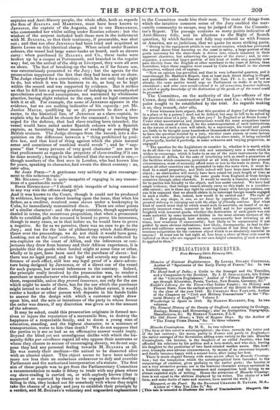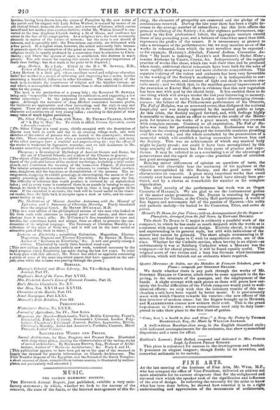PUBLICATIONS RECEIVED.
From ?sensory 23d to February 291h.
Booas.
Memoirs of Eminent Englishwomen. By Loam STUART COSTELLO, Author of "Specimens of the Early Poetry of France," &c. In two volumes.
The Hand-book of India; a Guide to the Stranger and the Traveller, and a Companion to the Resident. By J. H. STOCQUELER, late Editor of the "Calcutta Englishman," Author of "Fifteen Months' Pilgrim- age through 'Charlatan, Persia, Turkey, New Russia, Germany, &o" Knight's Library for the Times—Our Indian Empire ; its History and Present State, from the earliest settlement of the British in Hindostaa to the close of the year 1843. By CHARLES Mee SARLANE, Author- of the Chapters on "Civil and Military Transactions" in the "Pic- torial History of England." Volume I. Wanderings in Spain in 1843. By MARTIN HAVERTY, Esq. In two volumes.
The Natural History of the Chanty of Stafford; comprising its Geology, Zoology, Botany, and Meteorology ; also its Antiquities, Topography, Manufactures, ZIC. By ROBERT GARNER, F.L.S. The Old Dower House; a Tale of Bygone Days. By the Author of "The Young Prima Donna," &c. lu three volumes.
Blanche Cressingham. By M. E. In two volumes. [The form of this novel is autobiographical; the time, towards the latter end of the last century; the scene, partly in France and partly in England,— the earlier outrages of the Revolution adding some variety to the tale. Blanche Cressingham, the heroine, is the daughter of an exiled Jacobite, who has offended his relations by his politics and a love.match, and who dies, leaving his daughter to the protection of two hard-minded maiden aunts. She, how- ever, triumphs over adverse circumstances, by means of an enormous bequest; and finally becomes happy with a second lover, after losing her first. There is much elegant fluency with some scenic effect in Blanche Creasing- ham; but the temptation which the autobiographical form furnishes to the outpourings of emotion, gives prolixity to the earlier parts ; the heroine is not a very attractive person, nor is the feminine character always sustained in a feminine manner ; and the treatment and composition both belong to an almost exploded style of writing. Hence the attraction of Blanche Creasing- ham is not equal to the abilities displayed by its writer. The choice of a bad form, and some faults of taste and manner, have marred the work.] Margaret, or the Pearl. By the Reverend CHARLES B. TArcen, ALA, Author of "May You Like It," &c.
[This tale is intended to illustrate the evils of Tractariaoism. Margaret, the
heroine, having been drawn into the errors of Puseyistn by the new rector of the parish and his elegant wife Lady Selina Walton, is rescued by means of an old clerical friend, domestic discussions, and a reverse of fortune, which carries herself and her mother into another district; whilst Mr. Walton himself is con- verted to the true Anglican Church during a fit of illness, and confesses his errors in the face of the congregation. As a religious tale, the book necessarily abounds in matter of the nature of sermon; but the story is not devoid of interest, and is agreeably told : the Tractarians, especially, are delineated with affine pencil. In a logical sense, however, the attack necessarily fails, because it proceeds upon the assumption of the point at issue. Domestic distress in a religious family is equally produced by a conversion from heathenism to Chris- tianity ; and where the system of caste is established, this distress is much greater. The sole reason for causing this misery is the greater importance of truth than feeling : but that truth is the point to be disputed.] Amy Herbert. By a Lady. Edited by the Rev. W. SEWELL, B.D., Fellow of Exeter College, Oxford. In two volumes. [Amy Herbert is a little girl, whose excellent moral and religious education under her mother is a means of reforming and improving her coucins, besides exercising a beneficial influence in other directions. The main object of the book is to inculcate the importance of religion and the kindlier virtues ; an end which is accomplished with more nature than is often exhibited in didactic tales for the young. The book is the production of a young lady ; the Reverend W. SEWELL being only "responsible for recommending its publication, and suggesting a few verbal corrections!' In the judgment this recommendation implies we agree. Although the narrative of Amy Herbert sometimes becomes prolix, the incidents are appropriate and often interesting, and the style is easy and elegant. There are also consistency and life in the work. It truly depicts the character and sentiments of very young ladies ; excelling in this point of view many, tales of much higher pretension.] The Silent Village; a Poem, with Notes. By THOMAS CLARKE, Author of "A Day in May," &c. To which is added, Corona Sylrestris, variis e flosculis contexta. [The Silent Village is a rural poem' chiefly occupied with the description of objects seen both in earth and sky in an evening village-walk, and with sketches of the career of persons who are buried in the churchyard ; whence the title. These narratives have often a resemblance to CHABBE ; and many of the other passages have a truthful and unpretending air: but the effect of the stories is weakened by digressive remarks ; and we still desiderate in Mr. CLARKE something more of the poetical vivida vis.] Theogony ; a Genealogical Mythology of Ancient Greece and Rome, for the use of ClassicalSchools, and readers of the Classics in general. ['The object of this publication is to exhibit in a tabular form a genealogical
ac-
count of the gods and heroes of the ancient mythology, including a brief notice of each, and sometimes the meaning of the name,—as Charon' favoured. The tabular arrangement consists of five columns, to contain father, mother, sons, daughters, and the functions or characteristics of the persons. The ar- rangement, designing to exhibit genealogy, is chronological, the ancestor of ne- cessity preceding the descendants: thus the wifeless Chaos opens the list. The difficulty of reference this would produce is obviated by an alphabetical index; and as every name is numbered there is no puzzle in turning to any,— though we think it may be a troublesome task to trace a long pedigree to its stem. If the execution is accurate, the book will be found useful to the classi- cal reader, from the little bulk it occupies upon a desk or table, and its conse- quent facility in use.] The Meditations of Marcus Aurelius Antoninus, wills the Manual of Epicletus, and a Summary of Christian Morality. Freely translated from the original Greek. By HENRY APConstac, M.D. [This is a neat edition of the philosophical axioms of two men who looked at life from such wide extremes as imperial power and slavery, and drew con- clusions from it much alike. Dr. M'Conusec's free translation is terse and forcible, but sometimes harsh and abrupt, from an effort to preserve the con- densation of the original language. The Summary of Christian Morality is a collection of the texts of Scripture ; and it will not be the least useful or attractive part of the book to many.] Lectures on Electricity ; comprising Galvanism, Magnetism, Electro- Magnetism, Magneto and Thermo-Electricity. By HENRY M. NOAD, Author of "Lectures on Electricity," &c. A new and greatly enlarged edition. Illustrated by nearly three hundred wood-cuts. [This new edition is an almost entirely new work, rendered necessary by the rapid progress which Electricity has made during the last few years. In order to keep pace with this advance, Mr. NoaD has added an appendix containing a précis of some of the most important papers that have appeared on the sub- ject, even while the volume was passing through the press.]
SERIALS.
Murray's Colonial and Home Library, No. FL—Bishop Heber's Indian
Journal, Part IF.
Stephens's Book of time Farm, Part XVIII.
Mrs. Frederick Lover's Lives of Eminent Females, Part H.
Bee's _Martin Chuzzlewit, No. XV. Our Mess, Nos. XXVII and XXVIII.
Chronicles of the Bastile, Part III.
Novel Newspaper, Part LXXL Maxwell's Irish Rebellion, Part III.
PERIODICALS.
Westminster Review, No. LXXX.
Journal of Agriculture, No. IV., New Series.
Magazines for March—Blackwood's, Tait's, Dublin University, Fraser's, Illuminated, Fisher's Colonial, Simmonds's Colonial, London Poly- technic, Chambers's Edinburgh Journal, Builder, Apprentice, British, Christian's Monthly, Artist and Amateur's, Portfolio, Chemist, Miroir Francais, Ladies' Cabinet.
ILLUSTRATED WORKS AND PRINTS.
Sacred Architecture, its Rise, Progress, and Present State. Illustrated
with sixty-three plates, showing the characteristics of the various styles
of sacred architecture. By RICHARD BROWN, Esq., Professor of Archi- tecture, Author of " Dome,tic Architecture," Sec. Parts L and II. [This publication appears to have been got up on the spur of the moment to supply the demand for popular information on Church-Architecture. The First Number disposes of the Egyptian, and the Second of the Greek Temples : a short account of them, compiled from various sources, is illustrated by outline- plates, not particularly well executed.]



























 Previous page
Previous page